
Jan Davidsz. de Heem or in-full Jan Davidszoon de Heem, also called Johannes de Heem or Johannes van Antwerpen or Jan Davidsz de Hem, was a still life painter who was active in Utrecht and Antwerp. He is a major representative of that genre in both Dutch and Flemish Baroque painting.
Kleitias was an ancient Athenian vase painter of the black-figure style who flourished c. 570–560 BCE. Kleitias' most celebrated work today is the François Vase, which bears over two hundred figures in its six friezes. Painted inscriptions on four pots and one ceramic stand name Kleitias as their painter and Ergotimos as their potter, showing the craftsmen's close collaboration. A variety of other fragments have been attributed to him on a stylistic basis.
The Kleophon Painter is the name given to an anonymous Athenian vase painter in the red-figure style who flourished in the mid-to-late 5th century BC. He is thus named because one of the works attributed to him bears an inscription in praise of a youth named "Kleophon". He appears to have been originally from the workshop of Polygnotos, and in turn to have taught the so-called Dinos Painter. Three vases suggest a collaboration with the Achilles Painter, while a number of black-figure works have also been attributed to him by some scholars.

Euphronios was an ancient Greek vase painter and potter, active in Athens in the late 6th and early 5th centuries BC. As part of the so-called "Pioneer Group,", Euphronios was one of the most important artists of the red-figure technique. His works place him at the transition from Late Archaic to Early Classical art, and he is one of the first known artists in history to have signed his work.
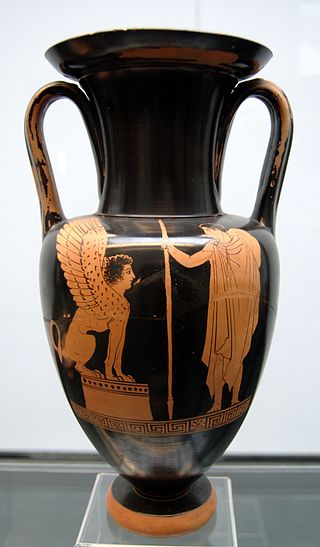
The Achilles Painter was a vase-painter active ca. 470–425 BC. His name vase is an amphora, Vatican 16571, in the Vatican museums depicting Achilles and dated 450–445 BC. An armed and armored Achilles gazes pensively to the right with one hand on his hip. The other hand holds a spear. On the opposite surface a woman performs libation.

The Niobid Painter was an ancient Athenian vase painter in the red-figure style who was active from approximately 470 to 450 BC. He is named after a calyx krater which shows the god Apollo and his sister Artemis killing the children of Niobe, who were collectively called the Niobids. The krater is known as the Niobid Krater and is now housed at the Louvre in Paris. In his other work he shows a preference for Amazonomachy scenes and three-quarter-view faces. His student Polygnotos continued his style of vase painting.
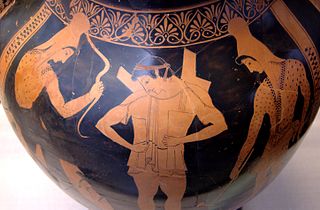
Euthymides was an ancient Athenian potter and painter of vases, primarily active between 515 and 500 BC. He was a member of the Greek art movement later to be known as the Pioneer Group for their exploration of the new decorative style known as red-figure pottery. Euthymides was the teacher of another Athenian red-figure vase painter, the Kleophrades Painter.
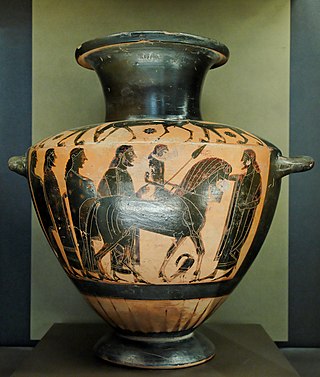
Lydos was an Attic vase painter in the black-figure style. Active between about 560 and 540 BC, he was the main representative of the '’’Lydos Group’’’. His signature, ό Λυδός, ho Lydos ", inscribed on two vases, is informative regarding the cultural background of the artist. Either he immigrated to Athens from the Lydian empire of King Kroisos, or he was born in Athens as the son of Lydian parents. In any case, he learned his trade in Athens.

The Amasis Painter was an ancient Greek vase painter who worked in the black-figure technique. He owes his name to the signature of the potter Amasis, who signed twelve works painted by the same hand. At the time of the exhibition, "The Amasis Painter and His World" (1985), 132 vases had been attributed to this artist.

The Providence Painter is the conventional name given to a painter of the Attic red-figure style. He was active around 470 BC.
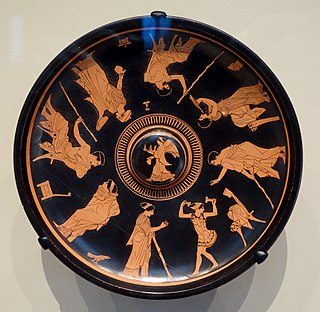
The Phiale Painter, also known as Boston Phiale Painter, was a painter of the Attic red-figure style. He was active around 460 to 430 BC. The Phiale Painter is assumed to have been a pupil of the Achilles Painter. In contrast to his master, he liked to depict narrative scenes. He painted several large calyx kraters, often with two registers of figures; unlike his master, he seems to have preferred larger vessels in general. This is shown by his white-ground works, which are not well known, but more expressive than those of the Achilles Painter. Apart from a number of lekythoi, he painted two chalice kraters in white-ground technique, a rarity at the time. His themes may be partially influenced by contemporary theatre. His preferred name for kalos inscriptions is that of Euaion, son of Aeschylus.
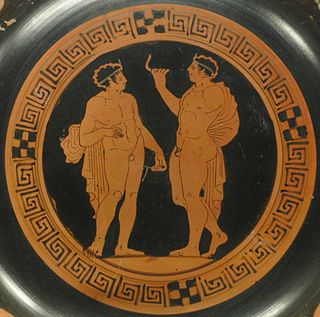
The Meleager Painter was an ancient Greek vase painter of the Attic red-figure style. He was active in the first third of the 4th century BC. The Meleager Painter followed a tradition started by a group of slightly earlier artists, such as the Mikion Painter. He is probably the most important painter of his generation. He painted a wide variety of vase shapes, including even kylikes, a rarity among his contemporaries.

The Shuvalov Painter was an Attic vase painter of the red-figure style, active between 440 and 410 BC, i.e. in the High Classical period in Magna Graecia.
Dietrich Felix von Bothmer was a German-born American art historian, who spent six decades as a curator at the Metropolitan Museum of Art, where he developed into the world's leading specialist in the field of ancient Greek vases.

The Altamura Painter was a classical Greek vase painter. Today about 127 different vases are attributed to him. Many of them were different types of pottery, such as amphorae, kraters, pelikei, and many others. The Altamura Painter's pottery work is dated from 475 BC to 425 BC. He mostly painted mythical gods and goddesses, as well as ordinary people.

Tityos Painter is the name given by modern scholarship to an Etruscan vase painter of the black-figure style. His real name is not known. His activity is dated to the third quarter of the sixth century BC.

The modern scholarly term Hâdra vases describes a group of Hellenistic painted hydriai. Apart from late Panathenaic prize amphorae, it is the only substantial group of figurally or ornamentally painted vases in the Greek world of the 3rd century BC.

The Underworld Painter was an ancient Greek Apulian vase painter whose works date to the second half of the 4th century BC.

The Amykos Painter was the name given to a South Italian vase painter who worked in the ancient Greek red-figure pottery technique. His exact date of birth and death are unknown.

The Villa Giulia Painter was an ancient Greek vase painter, active in Athens, Greece, from about 470 to 440 B.C. His real name is unknown, but like many other ancient Greek vase painters, his style was recognized in several works by the British classical archaeologist and international authority of Attic Greek vases, Sir John Beazley (1885–1970) in his book Attic Red-Figured Vases in American Museums.

















